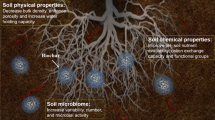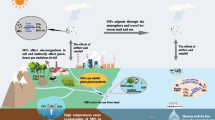Abstract
Along with the growing requirement to reduce building carbon emissions, a need has arisen to find energy efficient means of improving the quality of indoor air. Indoor plants have been shown to be capable of reducing most air pollutants; however, practical numbers of potted plants will not have the capacity to control many forms of air pollution, especially CO2. Green walls are space-efficient means of increasing the density of indoor plants. We assessed an active green wall for its potential to reduce CO2 in chambers and a test room. Chlorophytum comosum and Epipremnum aureum were both effective cultivars for CO2 removal at light densities greater than 50 μmol m−2 s−1. Substrate ventilation increased the rate of CO2 draw down from chambers, possibly due to increased leaf gas exchange rates. Green walls were then tested in a 15.65-m3 sealed simulation room, allowing the calculation of clean air delivery rate (CADR) and air changes per hour (ACH) equivalents based on CO2 draw down. Rates of CO2 draw down were modest under typical brightly lit indoor conditions (50 μmol m−2 s−1); however, when light intensity was increased to relatively bright levels, similar to indoor conditions next to a window or with the addition of supplementary lighting (250 μmol m−2 s−1), a 1-m2 green wall was capable of significant quantifiable reductions of high CO2 concentrations within a sealed room environment. Extrapolating these findings indicates that a 5-m2 green wall containing C. comosum could balance the respiratory emissions of a full-time occupant.






Similar content being viewed by others
References
Afrin S (2009) Green skyscraper: integration of plants into skyscrapers. Dissertation, Kungliga Tekniska Hogskolan
ANSI/AHAM (2015) AC-1-2015: method for measuring the performance of portable household electrical room air cleaners. Association of Home Appliance Manufacturers, Washington DC
ASHRAE (2010) Standard 62.1-2010 ventilation for acceptable indoor air quality. ASHRAE, Atlanta
ASHRAE (2011) GreenGuide: the design, construction, and operation of sustainable buildings, 3rd edn. ASHRAE, Atlanta
Ayala A, Brauer M, Mauderly JL, Samet JM (2012) Air pollutants and sources associated with health effects. Air Quality Atmos Health 5:151–167
Aydogan A, Montoya LD (2011) Formaldehyde removal by common indoor plant species and various growing media. Atmos Env 45:2675–2682
Australia E (2001) Air toxics and indoor air quality in Australia, state of knowledge report Canberra. Environment Australia, Australia
Baosheng K, Shibata S, Sawada A, Oyabu T, Kimura H (2009) Air purification capability of potted Phoenix roebelenii and its installation effect in indoor space. Sensor Mater 21:445–455
Bernstein JA, Alexis N, Bacchus H, Bernstein IL, Fritz P, Horner E et al (2008) The health effects of nonindustrial indoor air pollution. J Allergy Clin Immun 121:585–591
Brennan J (2011) Do potted plants improve the indoor environment? Masters’ Dissertation, University of Technology Sydney
Chen W, Zhang JS, Zhang Z (2005) Performance of air cleaners for removing multiple volatile organic compounds in indoor air. ASHRAE Trans 111(1):1101–1104
Cornejo JJ, Munoz FG, Ma CY, Stewart AJ (1999) Studies on the decontamination of air by plants. Ecotoxicology 8:311–320
Darlington A, Dat J, Dixon M (2001) The biofiltration of indoor air: air flux and temperature influences the removal of toluene, ethylbenzene, and xylene. Environ Sci Technol 35:240–246
Erdmann CA, Apte MG (2004) Mucous membrane and lower respiratory building related symptoms in relation to indoor carbon dioxide concentrations in the 100-building BASE dataset. Indoor Air 14:127–134
Gawrońska H, Bakera B (2015) Phytoremediation of particulate matter from indoor air by Chlorophytum comosum L. plants. Air Qual Atmos Health 8:265–272
Godish T, Guindon C (1989) An assessment of botanical air purification as a formaldehyde mitigation measure under dynamic laboratory chamber conditions. Environ Pollut 62:13–20
Guo S, Ai W, Tang Y, Cheng Q, Shen Y, Qin L et al (2014) Study on O2 generation and CO2 absorption capability of four co-cultured salad plants in an enclosed system. Adv Space Res 53:1551–1556
Hutton G (2013) Air pollution: global damage costs. In: Lomborg B (ed) How much have global problems cost the world? Cambridge University Press, New York
Irga PJ, Torpy FR, Burchett MD (2013) Can hydroculture be used to enhance the performance of indoor plants for the removal of air pollutants? Atmos Env 77:267–271
Kim KJ, Kim HD (2008) Development of model and calculating equation for rate of volatile formaldehyde removal of indoor plants. Hort Environ Biotechnol 49:155–161
Lee HL, Choi B, Chu MY (2015) Stabilizing soil moisture and indoor air quality purification in a wall-type botanical biofiltration system controlled by humidifying cycle. Korean Journal of Horticultural Science and Technology 33(4):605–617
Massa GD, Kim HH, Wheeler RM, Mitchell CA (2008) Plant productivity in response to LED lighting. HortSci 43(7):1951–1956
Milton DK, Glencross PM, Walters MD (2000) Risk of sick leave associated with outdoor air supply rate, humidification, and occupant complaints. Indoor Air 10:212–221
Morey PR, Crawford GN, Rottersman RB (2001) Indoor air quality in nonindustrial occupational environments. In: Patty's industrial hygiene and toxicology. John Wiley & Sons, Inc., New York
Norbäck D, Nordström K (2008) Sick building syndrome in relation to air exchange rate, CO2, room temperature and relative air humidity in university computer classrooms: an experimental study. Int Arch Occup Environ Health 82:21–30
Oh G, Jung G, Seo M, Im Y (2011) Experimental study on variations of CO2 concentration in the presence of indoor plants and respiration of experimental animals. Hortic Environ Biotechnol 52:321–329
Orwell RL, Wood RA, Tarran J, Torpy FR, Burchett M (2004) Removal of benzene by the indoor plant/ substrate microcosm and implications for air quality. Water Air Soil Poll 157:193–207
Pennisi SV, van Iersel MW (2012) Quantification of carbon assimilation of plants in simulated and in situ interiorscapes. Hortscience 47:468–476
Pérez-Urrestarazu L, Fernández-Cañero R, Franco A, Egea G (2016) Influence of an active living wall on indoor temperature and humidity conditions. Ecol Eng 90:120–124
Redlich C, Sparer J, Cullen M (1997) Sick-building syndrome. Lancet 349:1013–1016
Safe Work Australia (2011) Managing the work environment and facilities: code of practice. Safe Work Australia, Canberra
Schell M, Inthout D (2001) Demand control ventilation using CO2. ASHRAE J 2001:1–6
Seppänen OA, Fisk WJ (2004) Summary of human responses to ventilation. Indoor Air 14:102–118
Somova LA, Pechurkin NS (2001) Functional, regulatory and indicator features of microorganisms in man-made ecosystems. Adv Space Res 27:1563–1570
Soreanu G, Dixon M, Darlington A (2013) Botanical biofiltration of indoor gaseous pollutants—a mini-review. Chem Eng J 229:585–594
Soreanu G (2016) Biotechnologies for improving indoor air quality. In: In start-up creation, Chapter 12. Woodhead Publishing, pp. 301–328
Tarran J, Torpy F, Burchett MD (2007) Use of living pot-plants to cleanse indoor air. Research Review. 6th International Conference on Indoor Air Quality. Ventilation & Energy Conservation—Sustainable Built Environment. Sendai, Japan pp. 249–56
Torpy FR, Irga PJ, Burchett MD (2014) Profiling indoor plants for the amelioration of high CO2 concentrations. Urban Forestry and Urban Greening 13:227–233
Wang Z (2011) Dynamic botanical filtration system for indoor air purification (PhD Thesis). Mechanical and Aerospace Engineering. Dissertations, Paper 63
Wang Z, Pei J, Zhang JS (2014) Experimental investigation of the formaldehyde removal mechanisms in a dynamic botanical filtration system for indoor air purification. J Hazard Mat 280:235–243
Wang Z, Zhang JS (2011) Characterization and performance evaluation of a full-scale activated carbon-based dynamic botanical air filtration system for improving indoor air quality. Build Environ 46:758–768
WHO (2014) Burden of disease from household air pollution for 2012. WHO Regional Office for Europe, Copenhagen
Wolverton BD, Wolverton JD (1993) Plants and soil microorganisms: removal of formaldehyde, xylene and ammonia from the indoor environment. Journal of the Mississippi Academy of Sciences 38(2):11–15
Wood RA, Orwell RL, Tarran J, Torpy FR, Burchett MD (2002) Potted-plant/growth media interactions and capacities for removal of volatiles from indoor air. J Hortic Sci Biotechnol 77(1):120–129
Xu Z, Wang L, Hou H (2011) Formaldehyde removal by potted plant–soil systems. J Hazard Mat 192:314–318
Acknowledgements
This research was funded by an Australian Government Department of Industry Research Connections linkage project with Junglefy Pty Ltd. None of the authors have any commercial connection with either the funding body or Junglefy Pty Ltd. beyond the scope of this research project. We would like to thank Ashley Naomi Jane Douglas, Iain Berry and Russell Trenerry for their professional editing assistance with this work, and Gemma Armstrong for laboratory management.
Authors’ contributions
FRT and PJI designed the study, PJI and MZ collected the experimental data, FRT analysed the data and wrote the manuscript, and PJI edited the manuscript.
Author information
Authors and Affiliations
Corresponding author
Electronic supplementary material
ESM 1
(XLSX 26 kb)
Rights and permissions
About this article
Cite this article
Torpy, F., Zavattaro, M. & Irga, P. Green wall technology for the phytoremediation of indoor air: a system for the reduction of high CO2 concentrations. Air Qual Atmos Health 10, 575–585 (2017). https://doi.org/10.1007/s11869-016-0452-x
Received:
Accepted:
Published:
Issue Date:
DOI: https://doi.org/10.1007/s11869-016-0452-x




